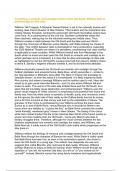'In painting a romantic and nostalgic picture of the Old South, Williams fails to
acknowledge its dark side'.
Williams 1947 tragedy, A Streetcar Named Desire, is set in the culturally diverse and
working class French Quarter of New Orleans. This location and the characters here,
notably Stanley Kowalski, contrast the aristocratic Old South the DuBois sisters have
come from. As a consequence of the civil war, Southern confederate states like
theirs declined, making way for the industrial working and middle class. Thus,
Williams creates a clash between the Old South and the New post-war World -
through the microcosm of Blanche versus Stanley, with Stella making her choice of
the latter. This conflict between class is dramatised in many productions, especially
the 2020 National Theatre one where it is periodless, emphasising how class conflict
is applicable to many societies. While Williams himself was from Mississippi in the
South which he loved and does paint the Old South as romantic and nostalgic to an
extent (perhaps as he is biassed), it is clear that he does acknowledge its dark side -
as highlighted by how the Old South's success was built from slavery, Stella's choice
to leave it, Stanley's negative attitudes towards it, and its old fashioned attitudes.
Williams physically presents the Old South as romantic and nostalgic through the
DuBois' plantation and ancestral home, Belle Reve, which personifies it - similar to
the Tara plantation in Mitchell's Gone With The Wind. In French this translates to
'beautiful dream', so from the outset it is romanticised. It is likely inspired by Belle
Rive country club where a teenage Williams and his mother used to visit. Here she
would try to gain social class-like Blanche - and it is also where Williams fell and
broke his teeth. This warns of the dark side of Belle Reve and the Old South, as a
place that will inevitably cause destruction and embarrassment. Williams uses the
grand visual imagery of "white columns" to emphasise how powerful their home and
family was. Here the white colour is symbolic of wealth, purity, and innocence; ironic
as this ignores the dark side of their reality as the DuBois family has lost its money
and is far from innocent as that money was built on the exploitation of slaves. The
grandeur of their home is emphasised by how Williams portrays the lower class
Eunice as in awe of Belle Reve, versus Blanche who is shocked at Stella's new
home which she belittles to: "a place like this", as Belle Reve contrasts the smaller
"white frame[d], weathered grey" homes in New Orleans. The fading of the colour
white here instead implies that life in the industrial New World of the french quarter is
poorer and more realistic than the Old South - hence why Blanch who lives in
fantasy struggles there. Therefore, although the visual contrast between the two
locations emphasises how romantic and nostalgic the sisters, and Williams, see
Belle Reve as, it subtly warns of the Old South's dark reality which progresses as the
play goes on.
Williams reflects the feelings of romance and nostalgia towards the Old South and
Belle Reve through the character of Blanche the most. While Stella is visibly upset
that Belle Reve has been lost, as seen in her exclamatory speech, she chose to
leave the Old South at a young age. This reflects how desperate she was and
suggests that unlike Blanche, she could see its dark reality. Whereas, Williams
portrays Blanche as angry at Stella for leaving, which Williams shows through his
repetition of "you left, the summer Dad died, you left us" or "you looked out for
yourself!". Instead, Blanche nursed her dying family members and hyperbolically




